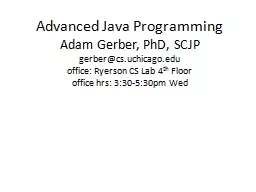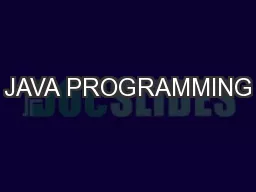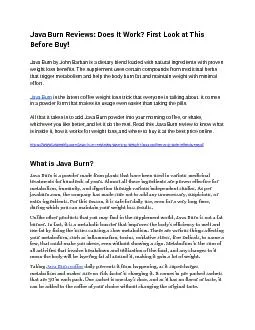PPT-Advanced Java Programming
Author : jane-oiler | Published Date : 2019-11-20
Advanced Java Programming Adam Gerber PhD SCJP gerbercsuchicagoedu office Ryerson CS Lab 4 th Floor office hrs 330530pm Wed Survey of the class Your name hailing
Presentation Embed Code
Download Presentation
Download Presentation The PPT/PDF document "Advanced Java Programming" is the property of its rightful owner. Permission is granted to download and print the materials on this website for personal, non-commercial use only, and to display it on your personal computer provided you do not modify the materials and that you retain all copyright notices contained in the materials. By downloading content from our website, you accept the terms of this agreement.
Advanced Java Programming: Transcript
Download Rules Of Document
"Advanced Java Programming"The content belongs to its owner. You may download and print it for personal use, without modification, and keep all copyright notices. By downloading, you agree to these terms.
Related Documents




![[FREE]-Java Java For Beginners Guide To Learn Java And Java Programming (Java Programming](https://thumbs.docslides.com/970816/free-java-java-for-beginners-guide-to-learn-java-and-java-programming-java-programming-books.jpg)
![[FREE]-Java: This book includes: Java Basics for Beginners + Java Front End Programming](https://thumbs.docslides.com/973042/free-java-this-book-includes-java-basics-for-beginners-java-front-end-programming-java-back-end-programming.jpg)
![[FREE]-c programming textbook.c programming book.c programming language.c programming.c](https://thumbs.docslides.com/979920/free-c-programming-textbook-c-programming-book-c-programming-language-c-programming-c-programming-visual-quickstart-guide-c-programming-for-dummies-absolute-beginner-s-beginner-exercises-in-easy-steps.jpg)
![[eBOOK]-Programming 60: C++ Programming Professional Made Easy & MYSQL Programming Professional](https://thumbs.docslides.com/980127/ebook-programming-60-c-programming-professional-made-easy-mysql-programming-professional-made-easy-c-programming-c-language-c-for-beginners-c-mysql-programming-mysql-c-programming.jpg)
![[FREE]-Programming 16: Python Programming In A Day & C Programming Professional Made Easy](https://thumbs.docslides.com/980148/free-programming-16-python-programming-in-a-day-c-programming-professional-made-easy-c-programming-c-programming-c-programming-language-html-python-python-programming-coding-css-java-php.jpg)
![[READING BOOK]-C: Programming: Computer Programming for Beginners: Learn the Basics of](https://thumbs.docslides.com/980690/reading-book-c-programming-computer-programming-for-beginners-learn-the-basics-of-c-coding-c-programming-java-programming-c-programming-javascript-python-php.jpg)
![[PDF]-C: Programming: Computer Programming for Beginners: Learn the Basics of C (Coding,](https://thumbs.docslides.com/990051/pdf-c-programming-computer-programming-for-beginners-learn-the-basics-of-c-coding-c-programming-java-programming-c-programming-javascript-python-php.jpg)